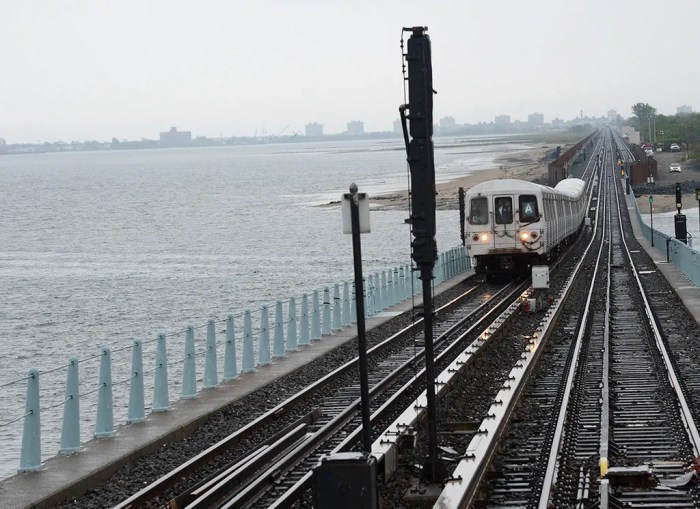By Helen Klein
Over the years, preservation in Bay Ridge has been a matter of a few giant steps forward and just as many back. Victoria Hofmo, the founder of the Bay Ridge Conservancy and the new preservation chairperson for the Bay Ridge Community Council (BRCC), told those gathered at William McKinley Intermediate School, I.S. 259, 7301 Fort Hamilton Parkway, for the group’s January meeting that years of effort had yielded some significant saves. Even so, she added, many cherished buildings have fallen under the wrecking ball to be replaced by the boxy, multifamily condominiums that she long ago dubbed “Fedders houses” because their most distinctive architectural feature was their through-the-wall air conditioners. The first save, Hofmo recalled, was the Farrell Bennett house, an 1840s-era farmhouse on 95th Street near Shore Road that was landmarked in 1999, though its companion building, older but less architecturally significant, was razed to make way for condominiums. “It was a three-year battle,” Hofmo told her listeners, “and a third of the property was saved. From that, I started the Bay Ridge Conservancy. I said that saving one building every three years was not going to be very effective. We have to try other things.” Among these was an effort to get distinctive streets designated on the State and National Registers of Historic Places. To date, both Senator Street, between Third and Fourth Avenues, and Ovington Avenue, between Third Avenue and Ridge Boulevard, have received that distinction, noted Hofmo. She said that both streets are now looking for New York City landmark designation, a move that brings with it restrictions on exterior alteration and can effectively protect existing structures from demolition by developers. Hofmo noted that, while it’s possible to get attached rowhouses designated, it’s way harder to get the same treatment for free-standing homes, even though those are the buildings that are “most in danger.” Both city and state agencies, Hofmo said, prefer groups of buildings designed by the same architect. Nonetheless, while landmarking of many of the area’s individual homes isn’t likely, Hofmo said that the recent rezoning of Bay Ridge had served to limit the possibilities on many blocks, as far as developers are concerned. “Contextual zoning doesn’t preserve houses,” she noted, “but it makes it less advantageous to the developer. It’s not a be-all-and-end-all, but it helps.” As she spoke, Hofmo lamented the houses that have gone. In particular, she recalled the fight to save a Victorian home on 80th Street, between Fourth and Fifth Avenues. Despite community efforts to save the home, and despite a purchase offer by local activist Rosemarie O’Keefe and her husband, the venerable old building was in fact torn down and replaced by condos. “I think the real estates have to realize there is just as much value in single family homes,” O’Keefe went on. “Boom, boom, boom. Sell, sell, sell, sell, and we’re losing all this character.” Also, said Hofmo, preservation is a key to maintaining the scale of the existing community. New construction usually adds density, so over-development can result in strains on the infrastructure as well as a diminished quality-of-life, she pointed out. Profit is obviously the main reason why over-development takes place, particularly in what has been an overheated real estate market. But, said Hofmo, lack of sufficient government oversight makes it easier for developers to capitalize on their projects. “The administration is very pro-development,” Hofmo noted. “Oversight is abysmal. Legislative changes need to be made, but that’s not easy. Plus, they often get tax breaks for destroying your neighborhood.” In particular, Hofmo cited self-certification – whereby an architect tells the Department of Buildings (DOB) that the plans being submitted are in compliance with both the building and the zoning code – as a major problem. With the recent building boom, DOB often relies on these assertions, and sometimes things get built that are outside the zoning or not in compliance with building requirements. “Laws favor developers,” Hofmo added. For instance, she said, “if one wall is left standing, it’s not considered a demolition. You can demolish a building without certified plans (for a new one). And, even if you have the zoning (to curtail the scope of a particular project), there are ways to break it – variances and special permits.” In addition, the recent rezoning of Bay Ridge, while it protected many interior blocks, left opportunity for development along Fourth Avenue, where many of the community’s churches – such as the Bay Ridge United Methodist Church, the “Green Church” – are located. These are especially vulnerable, therefore, Hofmo stressed. “We have to really pay attention and find solutions,” she told the group. “The churches are our legacy. So many of our ancestors came here poor and put everything into these buildings.” Some churches have already begun to battle back from financial difficulties, Hofmo noted, citing Bethlehem Lutheran Church, Good Shepherd Lutheran Church and Christ Church. Indeed, she said, while the congregation of the Green Church had rejected a Con Edison Renaissance Housing Program proposal to build below-market-rate senior housing on the church parking lot to provide the church with an income of $300,000 or more a year, three other neighborhood churches had expressed interest in having the same project done on their property. “Two may do it,” she added.


































